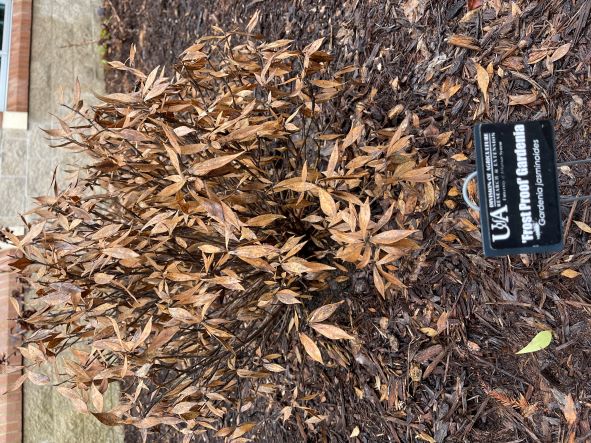Delay pruning woody ornamental plants damaged by winter temperatures
Feb. 17, 2023
By Rebekah Hall
U of A System Division of Agriculture
Fast Facts:
- Negative temperatures, wind chill damaged woody ornamental plants throughout Arkansas
- Delay pruning until growth begins in spring
- Symptoms of winter damage include sun-scalding, bark splitting, tip and branch dieback
(390 words)
(Newsrooms: With art at https://flic.kr/s/aHBqjAsktf)
LITTLE ROCK — Woody ornamental plants that suffered damage from this winter’s single-digit temperatures and wind chills shouldn’t be pruned until spring growth begins, said Randy Forst, extension consumer horticulture educator for the University of Arkansas System Division of Agriculture.
“February is the month that we usually prune our woody ornamentals,” Forst said. “This year we will have to make an exception to that rule. Usually, woody ornamentals have time to gradually acclimate to winter temperatures, but that did not happen this past winter.”
Woody ornamental plants include gardenias, camellias, shade-loving hydrangeas, and witch hazel family members, the loropetalums and distyliums. Forst said the sapwood, or the young wood of the plant, and the cambium, the layer of the plant that produces new bark, suffered the most damage from the winter temperatures.
Beneath the cambium layer are two important parts of the plant’s vascular system — the phloem, which carries food from the leaves to different parts of the plant, and the xylem, which transports water and other minerals from the roots to the leaves.
“If the nutrient and water transport system is damaged, the true damage to the plant may not be evident until new growth begins the following spring,” Forst said.
Symptoms of winter damage injury can appear as tip and branch dieback – or the progressive death of twigs or branches, starting at the tips – bark splitting, sun-scalding, leaf browning or defoliation.
“Winter damage can also be attributed to secondary issues, such as the branches leafing out normally and then suddenly dying for no obvious reason,” Forst said. “After the damaged plants break dormancy in the spring, you will have a better understanding of what needs to be pruned and how low to go.”
To help minimize winter injury in the future, Forst said he suggested selecting native plants, maintaining adequate soil moisture in the root ball area before the ground freezes, and avoiding late summer or early fall fertilization. “This is the wrong time to encourage new growth,” he said.
Forst also suggested matching plants to their site, avoiding planting broadleaf evergreens in open, windy locations. Mulching the plant will also help conserve moisture and help insulate the root ball.
Forst is also coordinator of the Arkansas Master Gardener program. For more information, contact Forst at rforst@uada.edu, or check out Forst’s blog The Arkansas Garden and follow along on Instagram @TheArkansasGarden.
To learn about extension programs in Arkansas, contact your local Cooperative Extension Service agent or visit www.uaex.uada.edu. Follow us on Twitter and Instagram at @AR_Extension. To learn more about Division of Agriculture research, visit the Arkansas Agricultural Experiment Station website: https://aaes.uada.edu. Follow on Twitter at @ArkAgResearch. To learn more about the Division of Agriculture, visit https://uada.edu/. Follow us on Twitter at @AgInArk.
About the Division of Agriculture
The University of Arkansas System Division of Agriculture’s mission is to strengthen agriculture, communities, and families by connecting trusted research to the adoption of best practices. Through the Agricultural Experiment Station and the Cooperative Extension Service, the Division of Agriculture conducts research and extension work within the nation’s historic land grant education system.
The Division of Agriculture is one of 20 entities within the University of Arkansas System. It has offices in all 75 counties in Arkansas and faculty on five system campuses.
Pursuant to 7 CFR § 15.3, the University of Arkansas System Division of Agriculture offers all its Extension and Research programs and services (including employment) without regard to race, color, sex, national origin, religion, age, disability, marital or veteran status, genetic information, sexual preference, pregnancy or any other legally protected status, and is an equal opportunity institution.
# # #
Media Contact:
Rebekah Hall
rkhall@uada.edu
@RKHall_
501-671-2061
